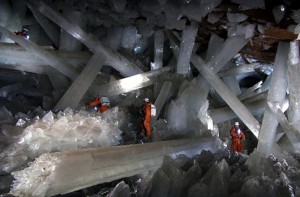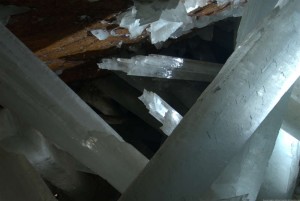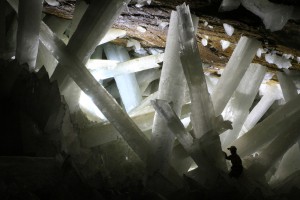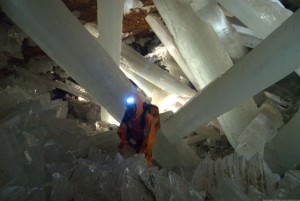 Cave of the Crystals or Giant Crystal Cave (Spanish: Cueva de los Cristales) is a cave connected to the Naica Mine 300 metres (980 ft) below the surface in Naica, Chihuahua, Mexico.
Cave of the Crystals or Giant Crystal Cave (Spanish: Cueva de los Cristales) is a cave connected to the Naica Mine 300 metres (980 ft) below the surface in Naica, Chihuahua, Mexico.
The main chamber contains giant selenite crystals (gypsum, CaSO4·2 H2O), some of the largest natural crystals ever found. The cave’s largest crystal found to date is 12 m (39 ft) in length, 4 m (13 ft) in diameter and 55 tons in weight. The cave is extremely hot, with air temperatures reaching up to 58 °C (136 °F) with 90 to 99 percent humidity. The cave is relatively unexplored due to these factors. Without proper protection, people can only endure approximately ten minutes of exposure at a time.
A group of scientists known as the Naica Project have been heavily involved in researching these caverns.
 Formation Of The Crystals:
Formation Of The Crystals:
Naica lies on an ancient fault above an underground magma chamber below the cave. The magma heated the ground water which was saturated with sulfide ions (S2−). Cool oxygenated surface water contacted the mineral saturated heated water, but the two did not mix due to the difference in their densities. The oxygen slowly diffused into the heated water and oxidized the sulfides (S2−) into sulfates (SO42−). The hydrated sulfate gypsum crystallized at an extremely slow rate of over the course of at least 500,000 years forming the enormous crystals found today. The key to this process is the slow diffusion of oxygen from the cool, low density surface water into the hot, high density ground water.
Discovery:
In 1910 miners discovered a cavern beneath the Naica mine workings, the Cave of Swords (Spanish: Cueva de las Espadas). It is located at a depth of 120 m, above the Cave of Crystals, and contains spectacular, smaller (1 m long) crystals. It is speculated that at this level, transition temperatures may have fallen much more rapidly, leading to an end in the growth of the crystals.
Giant Crystal Cave was discovered in 2000 by miners excavating a new tunnel for the Industrias Peñoles mining company located in Naica, Mexico, while drilling through the Naica fault, which they were concerned would flood the mine. The mining complex in Naica contains substantial deposits of silver, zinc and lead.
The Cave of Crystals is a horseshoe-shaped cavity in limestone. Its floor is covered with perfectly faceted crystalline blocks. Huge crystal beams jut out from both the blocks and the floor. The caves are accessible today because the mining company’s pumping operations keep them clear of water. If the pumping were stopped, the caves would again be submerged in water. The crystals deteriorate in air, so the Naica Project is attempting to visually document the crystals before they deteriorate further.
Two other smaller caverns were also discovered in 2000, Queen’s Eye Cave and Candles Cave, and a further chamber was found in a drilling project in 2009. The new cave, named Ice Palace, is 150 m deep and is not flooded, but its crystal formations are much smaller, with small ‘cauliflower’ formations and fine, threadlike crystals. All of the caves discovered currently are: Cave of Crystals, Queen’s Eye, Candles Cave, Ice Palace and Cave of Swords.
 Exploration and Scientific Studies:
Exploration and Scientific Studies:
A scientific team coordinated by Paolo Forti, specialist of cave minerals and crystallographer at the University of Bologna (Italy) explored the cave in detail in 2006. To survive and to be able to work in the extreme temperature and humid conditions which prevent prolonged incursion in the crystal chamber, they developed their own refrigerated suits and cold breathing systems (respectively dubbed Tolomea suit and Sinusit respirator). Special caving overalls were fitted with a mattress of refrigerating tubes placed all over the body and connected to a backpack weighing about 20 kg (44 lbs) containing a reservoir filled with cold water and ice. The cooling provided by melting ice was sufficient to provide about half an hour of autonomy.
Beside mineralogical and crystallographic studies, biogeochemical and microbial characterization of the gypsum giant crystals were also performed. Stein-Erik Lauritzen (University of Bergen, Norway) performed uranium-thorium dating to determine the maximum age of the giant crystals, about 500,000 years.
Penelope Boston (New Mexico Institute of Mining and Technology), speleologist and geomicrobiologist specialist of extremophile organisms realized sterile sampling of gypsum drillcores by making small boreholes inside large crystals under aseptic conditions. The aim was to detect the possible presence of ancient bacteria encapsulated inside fluid and solid inclusions present the calcium sulfate matrix from its formation.
Solid inclusions mainly consist of magnesium and iron oxy-hydroxide but no organic matter could be found associated with the solid hydroxides. No DNA from ancient bacteria could be extracted from the solid inclusions and amplified by PCR.
Microbial studies on fluid inclusions are foreseen to attempt to evidence the presence of ancient micro-organisms in the original fluid solution in which the crystals developed.
Other researches also cover the fields of palynology (pollen study), geochemistry, hydrogeology and the physical conditions prevailing in the Cave of Crystals.
 Future Closure:
Future Closure:
The cave was featured on the Discovery Channel program Naica: Beyond The Crystal Cave in February 2011. Exploration has given credence to the existence of further chambers, but further exploration would have required significant removal of the crystals. It was stated[by whom?] that the cave would eventually be resealed and the water level allowed to rise again.
Did you know that if you subscribe to our website, you will receive email notifications whenever content changes or new content is added.
1. Enter your e-mail address below and click the Sign Me Up button.
2. You will receive an email asking you to confirm your intention of subscribing to our site.
3. Click the link in the email to confirm. That’s all there is to it! Note: if you wish to unsubscribe from our site, click the unsubscribe link at the bottom of the email you received.
Then indicate you no longer wish to receive our emails.
Thank You
Dialect Zone International